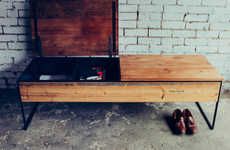
Cheungvogl Creates Furniture from Old Chinese Wooden Vessels
Kevin Young — May 8, 2012 — Art & Design
References: cheungvogl & designboom
Chinese-German architecture firm Cheungvogl uses old wood planks from Chinese boats to create an amazingly beautiful installation. Wood designs are becoming more popular in modern decor, offering a rustic feel in contemporary settings. The use of naturally aged timber offers a touch of history and a beautifully antique appeal.
The wooden cabinets made for Aesop, a shop located in Hong Kong, are assembled using the timber material left in its original state, which is decayed and worn out. The natural-made holes in the planks become the handles to open and close the drawers. This design is meant to be a representation of time and it's clearly visible through the use of naturally decaying wood. This is a gorgeous example of recreating furniture with the use of old materials.
Photo Credits: designboom, cheungvogl
The wooden cabinets made for Aesop, a shop located in Hong Kong, are assembled using the timber material left in its original state, which is decayed and worn out. The natural-made holes in the planks become the handles to open and close the drawers. This design is meant to be a representation of time and it's clearly visible through the use of naturally decaying wood. This is a gorgeous example of recreating furniture with the use of old materials.
Photo Credits: designboom, cheungvogl
Trend Themes
1. Aging Timber Designs - Repurposing naturally aged timber for furniture design presents a trend towards rustic and antique aesthetics, providing potential for disruptive innovation in sustainable and eco-friendly furniture creations using repurposed materials.
2. Boat Wood Installations - Creating installations and furniture from old repurposed wood from boats is becoming increasingly popular as an environmentally friendly design trend, offering opportunities for disruptions in furniture making to increase sustainability and reduce waste.
3. Rustic Contemporary Decor - The trend towards incorporating rustic and antique elements into contemporary decor has resulted in a demand for furniture made from repurposed wood that showcases natural decay, inspiring and enabling disruptive innovation for sustainable and eco-friendly furniture designs.
Industry Implications
1. Furniture - The furniture industry is ripe for disruption with the emerging trend of using aged, repurposed, and sustainable materials to cater to environmentally conscious consumers.
2. Architecture - Architects and designers can incorporate the use of repurposed materials in their designs for installations and furniture, offering opportunities for disruptive innovation in eco-friendly and sustainable building practices.
3. Sustainability - The trend to prioritize sustainability in design has led to a shift in focus towards creating innovative designs that incorporate repurposed and sustainable materials, providing opportunities for disruptive innovation in the manufacture and supply chain of sustainable materials for use in a variety of industries.
5.1
Score
Popularity
Activity
Freshness























